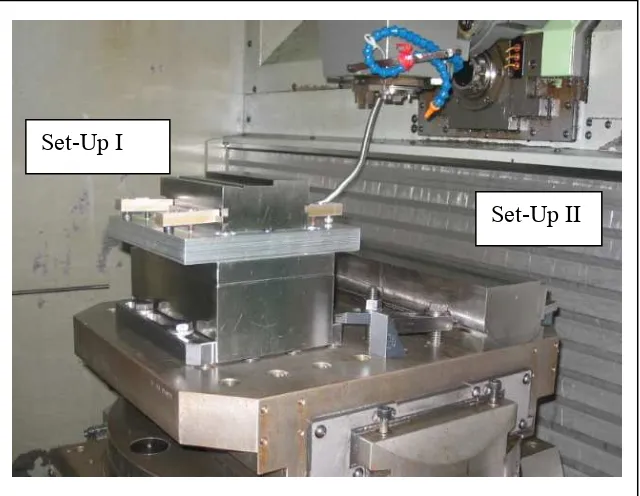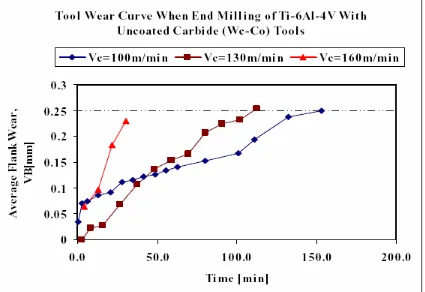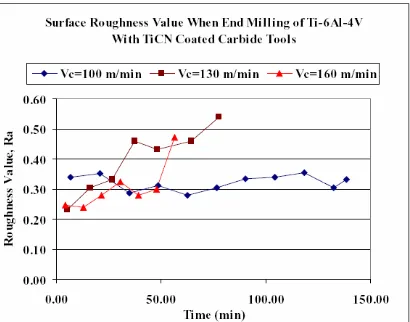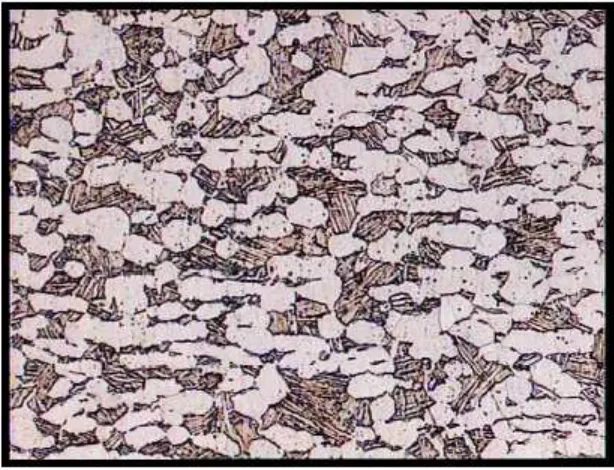INVESTIGATION THE SURFACE INTEGRITY OF UNCOATED AND
TICN COATED CARBIDES TOOLS WHEN END MILLING OF
TITANIUM ALLOY TI-6AL-4V
A.S. MOHRUNI1, S. SHARIF2, M. ISA3
Abstract
Titanium alloys are widely used in aerospace industries because of their superior mechanical properties. However, titanium alloys are material that extremely difficult to machine because of their low thermal conductivity and high chemical reactivity. Recently, with increasing demands for precision machining of titanium alloy have brought the development of hard coating tools in terms of optimizing the acceptable tool life, and thus minimize tool cost. An investigation of cutting performance of uncoated and TiCN coated carbide tools when end milling of aerospace titanium alloy, Ti-6Al-4V was carried out. Machining tests were conducted at various cutting speed with constant feed and depth of cut. The performance for both cutting tools was evaluated with respect to tool wear, surface integrity of machined surface. Results show that the TiCN coated carbide tool was better than uncoated carbide tools in term of surface finish for all cutting speeds observed. Plastic deformation was found on the machined subsurface for both carbide tools.
Keywords: End Milling, Titanium Alloy, Tool Wear, Surface Integrity.
I. INTRODUCTION
Titanium and its alloys are used widely in the aerospace, chemical and ship building industries because of their superior mechanical properties, heat and corrosion resistance. Titanium alloys, however, are materials that are extremely difficult to machine because of their poor machinability. During the machining of titanium alloy, tools wear progresses rapidly because of the high temperature and strong adhesion between the tool and the work material, due to their low thermal conductivity and high chemical reactivity.
Generally end mills are produced in solid HSS, WC-Co, ceramic; PCD/PCBN brazed or vein construction, inserted blade and indexable insert design. Recently, the development of wear-resistant hard coatings has brought a revolution in the metal cutting industry. These coatings, which are applied onto tool surfaces in only micro thickness layers, substantially improve tools performance and cutting economies. They allow an increasingly wide range of materials to be machined with lower tool wear, better finishes, reduced power consumption, and enhanced productivity. It is estimated that 80% or more of all machining operation nowadays are carried out using coated tools.
Hence considerations of selecting cutting conditions and tool material during end milling of titanium alloys are among important factors which directly affect the machining performance, surface enhancement, tool life, and manufacturing cost. The aims of this study are to investigate and evaluate the machining performance of uncoated and TiCN coated carbide end mills when machining titanium alloy, Ti-6Al-4V in term the surface integrity.
II. METHODOLOGI
This study covered investigations and evaluations about surface integrity under several cutting conditions. The experiments were performed at various cutting speeds with constant depth of
1
Lecturer at Sriwijaya University, which is currently a PhD-Candidate at Universiti Teknologi Malaysia. 2
Associate Prof. Dr., The supervisor of the first authors at Universiti Teknologi Malaysia. 3
cut and feed rate. Experimentation was terminated when the tool life criteria, failure mode and maximum average of flank wear according to ISO 8688-2 was achieved.
The experimentations were carried out on a MAHO 700S CNC machining center at cutting condition shown in TABLE 1.
TABLE 1, Cutting conditions for the Investigation
Tool tested Tungsten carbide (WC-Co) and TiCN coated carbide tools
End mills diameter 10 mm
Axial depth of cut ae 5 mm
Radial depth of cut ap 0.5 mm
Cutting speeds 100, 130, 160 m/min
Feed rate 0.04 mm/tooth
Cutting fluid Water soluble 6% concentration
For the machining trials, two types of experimental set-up were employed as shown in Figure 1. The first is set-up I where the titanium workpiece was mounted on the top of multi component force dynamometer, Kistler type 9265A with adapter type 9443B for measuring the cutting forces. In the set-up II, the Ti-6Al-4V block was securely clamped onto the machine table for conducting the performance testing.
Set-Up II Set-Up I
Figure 1. Experimental Set-Up for end Milling Testing.
analyzed. On the machined surface, surface roughness values were measured using a Taylor Hobson Surtronic +3 portable surface tester.
Machining test will be terminated when the cutting edge experienced any of the following tool life criteria adopted, which were uniform flank wear ≥ 0.2 mm, maximum flank wear ≥ 0.25 mm, chipping ≥ 0.4 mm, and catastrophic failure.
Workpiece used in the experimentation was alpha + beta titanium alloy Ti-6Al-4V (IMI 318). The nominal compositions of this alloy are given in TABLE 2.
TABLE 2, Nominal chemical composition (%) of titanium alloy Ti-6Al-4V
Al V Fe C Mo Mn Si Ti
6.37 3.89 0.16 0.002 < 0.01 < 0.01 0.01 Balance
III. RESULTS AND DISCUSSIONS
III.1. Wear Progression and Surface Roughness
Wear progression and the surface roughness occurred in machining tests of uncoated carbide tools were shown in Figure 2 and 3 respectively, while the TiCN coated carbide tools were shown in Figure 4 and 5 respectively.
Figure 2, Wear Progression of uncoated carbide tools when end milling Ti-6Al-4V at various cutting speeds
Figure 3, Surface roughness values of uncoated carbide tools when end milling Ti-6Al-4V at various cutting speeds
Figure 5, Surface roughness values of TiCN coated carbide tools when end milling Ti-6Al-4V at various cutting speeds
Poor surface roughness can be directly influenced by worn tool and vibration. For example the flank wear, build up edge and chipping affected the value of surface roughness. The surface roughness values when end milling of Ti-6Al-4V with uncoated and TiCN coated carbide tools at various cutting speeds result the highest surface roughness value 0.62µm when machining at 100 m/min with uncoated tool.
Initially, the increasing of cutting time led to an increase in roughness values for both uncoated and TiCN coated tools. This may due to increase of flank wear at the cutting edges during machining process. Furthermore, that rapid tool wear and chipping at cutting edge resulted in poor surface finish of the machined surface as reported by Che Haron. However, the values of surface roughness tended to become smoother when the cutting speed was increased. This result was also revealed and agreed by Zoya.
The roughness values were also found inconsistence and fluctuated during the intermediate cutting process. This is due to the build up edge (BUE) formation which occurred on the cutting edge (flutes) and may be affected by chemical reactivity of work material. This situation led to the surface roughness deterioration and alternately surface improvement during machining process (Ezugwu).
As comparison in term of surface finish, the TiCN coated carbide tools performed better than the uncoated carbide tools. The average of surface roughness values of TiCN coated carbide tools was less than the uncoated carbide tools for the respective cutting speeds. This may due to high wear resistance and chemical stability of TiCN coated tools.
increase of cutting time due to progression of non-uniform flank wear, build up edge and chipping at the cutting flutes. Other factors influencing the surface roughness are probably vibration and the tendency of tool deflection during the machining tests.
III.2. Surface Integrity
Investigation of surface integrity behaviour on machined subsurface were carried out for both uncoated and TiCN coated carbide tools. Initial microstructure of Ti-6Al-4V before machining process is shown in Figure 6.
Figure 6, Microstructure of titanium alloy, Ti-6Al-4V at magnification 200X
Combination of cutting parameters and types of cutting tools influenced directly the surface integrity behaviour of work material. Figure 7 shows the microstructures of machined subsurface after end milling with both uncoated and TiCN coated carbide tools.
From the observation, it was found that plastic deformation formed slightly underneath the machined surface when end milling with uncoated and TiCN coated carbide tools. This slight change in microstructure may due to the exceeding value of the yield point of the material which generally includes elongation of the grain structure and increased hardness. It was also revealed that the average depth of plastic deformation underneath the machined surface tend to increase slightly as cutting speed increased for both types of cutting tools.
IV. CONCLUSIONS
The investigation of surface integrity when end milling of titanium alloy, Ti-6Al-4V with uncoated and TiCN coated carbide were successfully conducted. From the observations, some conclusions can be summarized as follows:
1. The cutting speed and wear on the flank face influenced the machined surface roughness values. In general, it showed that the average roughness value decreased with increasing the cutting speed. Results also indicated that the performance of TiCN coated carbide tool when end milling of Ti-6Al-4V better than uncoated carbide tools in term of surface finish. The average of surface roughness value for TiCN coated carbide tools was less than uncoated carbide tools for each cutting speed.
2. Plastic deformation was observed on the top layer of machined surface when machining of Ti-6Al-4V with uncoated and TiCN coated carbide tools. However this alteration effect was insignificant and relatively small due to the utilization of low feed of 0.04 mm/tooth.
REFERENCES
Armarego, E.J.A., Verezub, S., Samaranyake, P., (2002), “The effects of coating on cutting models in machining operations”, Proceeding of the Institution Mechanical Engineers, (216), pp. 347-356.
Che Haron, C.H. and Jawaid, A. (2005), “The effect of machining on surface integrity of titanium alloy Ti-6Al-4V”, Journal of Materials Processing Technology, (166), pp.188-192.
Ezugwu, E.O., Bonney, J., Yamane, Y., (2003), “ An Overview of machinability of aeroengine alloys”, Journal of Materials Processing Technology, (134), pp. 233-253.
ISO 8688-2 (1989), Tool life testing in milling, Part 2, End Milling 1st edition.
Jawaid, A., Sharif, S., Koksal, S., (2000), “Evaluation of wear mechanism of coated carbide tools when face milling of titanium alloys”, Journal of Materials Processing Technology, (99)(1), pp.266-274.
Koenig, W. (1979), “Applied research on the machinability of Titanium and its alloys”, In Proc. 47th Meeting of AGARD Structural and Materials Panel, Florence, AGARD CP256, London, pp. 1-10.
Komanduri, R. (1982), “Some clarifications on mechanics of chip formation when machining titanium alloys”, Wear, (76), pp. 15-34.
Lopez de Lacalle, L.N., Perez, J. Llorente, J.I., Sanchez, J.A., (2000), “Advanced cutting conditions for milling of aeronautical alloys”, Journal of Materials Processing Technology, (100), pp. 1-11.
Sharif, S., Mohruni, A.S., (2005), “Performance evaluation of uncoated and TiCN coated carbide tools when end milling of Titanium Alloy Ti-6Al-4V”, In Proceeding of 8th International Conference on Quality in Research (QIR), ISSN: 1411-1284, Jakarta, Indonesia, 9-10 August 2005, ME15-MPSDO-01, pp. 1-5.





